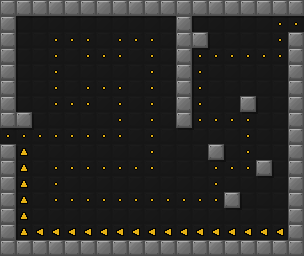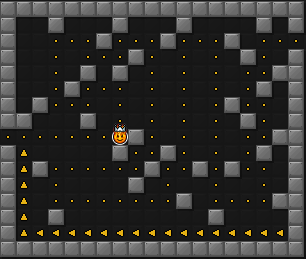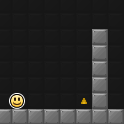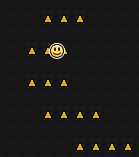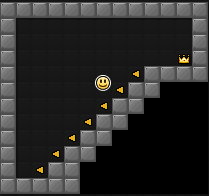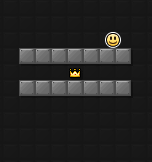Difference between revisions of "Common Puzzle"
Different55 (Talk | contribs) |
Different55 (Talk | contribs) |
||
| Line 8: | Line 8: | ||
== Dot trail == | == Dot trail == | ||
| − | [[File:DotTrail.png]] | + | [[File:DotTrail.png|right|frame]] |
Dot trails, also known as anti-gravity rails, consist of gravity dots chained together. The length of the trail varies depending on the level's designer, as well as the complexity. At times, it is possible to bypass lengths of the dot trail if the design permits. | Dot trails, also known as anti-gravity rails, consist of gravity dots chained together. The length of the trail varies depending on the level's designer, as well as the complexity. At times, it is possible to bypass lengths of the dot trail if the design permits. | ||
| − | [[File:DotTrailWithBlocks.png]] | + | [[File:DotTrailWithBlocks.png|right|frame]] |
Sometimes, level designers will add blocks at different spots in dot trails to make them simpler to navigate, as pictured above. By adding a solid block beyond the edge of an intended direction of travel, it prevents the player from flying off carelessly, as the player is squared with the next line of dots. | Sometimes, level designers will add blocks at different spots in dot trails to make them simpler to navigate, as pictured above. By adding a solid block beyond the edge of an intended direction of travel, it prevents the player from flying off carelessly, as the player is squared with the next line of dots. | ||
== Tight-fit == | == Tight-fit == | ||
| − | [[File:Tight fit.PNG]] | + | [[File:Tight fit.PNG|right|frame]] |
Before, Tight-Fit puzzles were much more tedious to complete since smileys had to be in the exact position before being able to successfully jump through a tight-fit hole. However, as of the latest update, a feature called grid-locking automatically aligns a smiley to the grid if close enough to a grid square. This makes passing these puzzles much easier. Once you can fit, you have to time your jump and movement correctly so you don't end up moving after the jump; losing your place and forcing you to start over. | Before, Tight-Fit puzzles were much more tedious to complete since smileys had to be in the exact position before being able to successfully jump through a tight-fit hole. However, as of the latest update, a feature called grid-locking automatically aligns a smiley to the grid if close enough to a grid square. This makes passing these puzzles much easier. Once you can fit, you have to time your jump and movement correctly so you don't end up moving after the jump; losing your place and forcing you to start over. | ||
| Line 21: | Line 21: | ||
Loop | Loop | ||
| − | [[File:Loop.PNG]] | + | [[File:Loop.PNG|right|frame]] |
If you find yourself in one of these pictured to the right, (no exit) then you are stuck moving forever. This is rarely found in puzzles, but it may be accompanied with dot trails and reverse gravity gimmicks so you can escape. They are not always in a square and can come in different shapes that can span large areas. Since the addition of gems and the shop, they have become increasingly popular for energy generators. These are used as AFKs (Away From Keyboard) sometimes. | If you find yourself in one of these pictured to the right, (no exit) then you are stuck moving forever. This is rarely found in puzzles, but it may be accompanied with dot trails and reverse gravity gimmicks so you can escape. They are not always in a square and can come in different shapes that can span large areas. Since the addition of gems and the shop, they have become increasingly popular for energy generators. These are used as AFKs (Away From Keyboard) sometimes. | ||
Hop-Skip | Hop-Skip | ||
| Line 31: | Line 31: | ||
== High jump == | == High jump == | ||
| − | [[File:EE2.PNG]] | + | [[File:EE2.PNG|right|frame]] |
High jump is a common puzzle that consists of a wall that is 4 or more blocks high. At the bottom it has an arrow, or a dot, for a high jumping. These can be affected by lag and can be learned over time. Some bugs, such as the multi-key bug on laptops can prevent players from completing these. Multiple arrows can be used with more than 4 blocks that requires the same method but gives a different look. A single block ceiling is often used for when multiple High Jumps are placed next to each other to prevent a player from jumping from the top of one to the top of another. | High jump is a common puzzle that consists of a wall that is 4 or more blocks high. At the bottom it has an arrow, or a dot, for a high jumping. These can be affected by lag and can be learned over time. Some bugs, such as the multi-key bug on laptops can prevent players from completing these. Multiple arrows can be used with more than 4 blocks that requires the same method but gives a different look. A single block ceiling is often used for when multiple High Jumps are placed next to each other to prevent a player from jumping from the top of one to the top of another. | ||
== Elevators == | == Elevators == | ||
| − | [[File:Elevators.png]] | + | [[File:Elevators.png|right|frame]] |
Elevators are usually designed to be quite tricky. The player can travel up them and usually has to move left or right to make sure they don't fall all the way back to the bottom. These are created by having alternating lines of spaces and arrows and can be recreated horizontally or vertically. The fewer arrows there are on a line, the less chance there is of continuing up the elevator, so you are more likely to fall back down it. The line of arrows will usually branch out into many different paths, which people must pick at random. There is usually only one path that actually takes the player up. The others either lead to a coin or a whole lot of nothing, causing the player to be sent back down. | Elevators are usually designed to be quite tricky. The player can travel up them and usually has to move left or right to make sure they don't fall all the way back to the bottom. These are created by having alternating lines of spaces and arrows and can be recreated horizontally or vertically. The fewer arrows there are on a line, the less chance there is of continuing up the elevator, so you are more likely to fall back down it. The line of arrows will usually branch out into many different paths, which people must pick at random. There is usually only one path that actually takes the player up. The others either lead to a coin or a whole lot of nothing, causing the player to be sent back down. | ||
== Arrow tower == | == Arrow tower == | ||
| − | [[File:Arrowtower.png]] | + | [[File:Arrowtower.png|right|frame]] |
An Arrow Tower consists of stairs with one arrow facing against you on each step. The easiest way to beat this challenge is by holding space and the arrow of the direction you want to go in. | An Arrow Tower consists of stairs with one arrow facing against you on each step. The easiest way to beat this challenge is by holding space and the arrow of the direction you want to go in. | ||
== Side-fit == | == Side-fit == | ||
| − | [[File:Side-Fit.png]] | + | [[File:Side-Fit.png|right|frame]] |
Side-fits are usually used in boss levels. The goal is to step off the top block and fit between both before the boss pushes you off with arrows. The simplest way to complete these is to lightly go off the top block and to directly press the opposite arrow when you start falling. | Side-fits are usually used in boss levels. The goal is to step off the top block and fit between both before the boss pushes you off with arrows. The simplest way to complete these is to lightly go off the top block and to directly press the opposite arrow when you start falling. | ||
== Coin puzzle == | == Coin puzzle == | ||
A coin puzzle is a kind of logic think puzzle. When you want to solve the puzzle you have to get the coins in the right order. When you fail you have to start again. Click 'Go to lobby', and then go back. Or as an alternative method: click 'Share' and copy the URL and paste it in your adressbar of your webbrowser and refresh the page as much as you need. | A coin puzzle is a kind of logic think puzzle. When you want to solve the puzzle you have to get the coins in the right order. When you fail you have to start again. Click 'Go to lobby', and then go back. Or as an alternative method: click 'Share' and copy the URL and paste it in your adressbar of your webbrowser and refresh the page as much as you need. | ||
Revision as of 01:02, 19 April 2015
These are common puzzles featured in EE. Entire rooms can be made out of them, but normally they are used in a single section of a room as a minigame.
Contents
Hook Jump
A picture showing the variations of the hookjump The Hook Jump (Other names: E-Block, Ninja Jump), consists of any solid block type with another solid block placed either two or three blocks above. They are sometimes accompanied by a wall to one side, as pictured on the right. There is also sometimes another wall placed two bricks to an open side of the Hook Jump, jumps which have these walls are generally considered easier as it's harder to overshoot. Some times the level creator will place a gravity dot or arrow on the block where the player stands to attempt to make it more challenging. But if they place an arrow that is pointed to push the player off, the player can simply hold space and the direction directly opposing the arrow, and they will quickly hop up the wall. Single space hook jumps are considered to be extremely difficult but can be completed. Hook Jumps are usually found chained together, and levels have been created that consist of nothing but Hook Jumps repeated over and over again.
Dot trail
Dot trails, also known as anti-gravity rails, consist of gravity dots chained together. The length of the trail varies depending on the level's designer, as well as the complexity. At times, it is possible to bypass lengths of the dot trail if the design permits.
Sometimes, level designers will add blocks at different spots in dot trails to make them simpler to navigate, as pictured above. By adding a solid block beyond the edge of an intended direction of travel, it prevents the player from flying off carelessly, as the player is squared with the next line of dots.
Tight-fit
Before, Tight-Fit puzzles were much more tedious to complete since smileys had to be in the exact position before being able to successfully jump through a tight-fit hole. However, as of the latest update, a feature called grid-locking automatically aligns a smiley to the grid if close enough to a grid square. This makes passing these puzzles much easier. Once you can fit, you have to time your jump and movement correctly so you don't end up moving after the jump; losing your place and forcing you to start over.
Anti-gravity drop
Similar to Tight-Fit, this puzzle needs you to drop from a height to a hole in the floor, and if you miss there are arrows to carry you to the top again. There are multiple variations to this and they can go in all directions except for upwards. Many use an arrow instead of an anti-gravity dot. Loop
If you find yourself in one of these pictured to the right, (no exit) then you are stuck moving forever. This is rarely found in puzzles, but it may be accompanied with dot trails and reverse gravity gimmicks so you can escape. They are not always in a square and can come in different shapes that can span large areas. Since the addition of gems and the shop, they have become increasingly popular for energy generators. These are used as AFKs (Away From Keyboard) sometimes. Hop-Skip
This is simply a block evenly (or unevenly) spaced usually with a drop or arrows below. These blocks are sometimes locks with a key on the end to send the others back to the beginning. They can range in difficulty and can have different gravity bricks placed on top of them, making it more difficult to land or jump from. Stairs
Stairs are locks stacked like stairs that ascend a tower, ultimately reaching the top of the stage. At the top the only way to pass to another part of the world is to go through a key in an opening, which will dump any unsuspecting players down to the bottom. Stair worlds usually consist of 3 - 4 stairs but can span across an entire world, taking up the entire minimap. Solid bricks are normally added near the walls to be used as safe spots or to catch falling players. Many players quit the level the moment they see stairs on the level. This is because they either believe it is un-original, easy, a waste of time, or simply there to take up space. It is relatively easy to be annoying in levels with stairs, as players who get to the top can just sit there on a block that is usually solid. They simply wait at the top, then they will drop down, hit the keys and drop other players when they see them getting close. These people will most likely use the Ninja Smiley if they have it, making themselves harder to see on the mini-map.
High jump
High jump is a common puzzle that consists of a wall that is 4 or more blocks high. At the bottom it has an arrow, or a dot, for a high jumping. These can be affected by lag and can be learned over time. Some bugs, such as the multi-key bug on laptops can prevent players from completing these. Multiple arrows can be used with more than 4 blocks that requires the same method but gives a different look. A single block ceiling is often used for when multiple High Jumps are placed next to each other to prevent a player from jumping from the top of one to the top of another.
Elevators
Elevators are usually designed to be quite tricky. The player can travel up them and usually has to move left or right to make sure they don't fall all the way back to the bottom. These are created by having alternating lines of spaces and arrows and can be recreated horizontally or vertically. The fewer arrows there are on a line, the less chance there is of continuing up the elevator, so you are more likely to fall back down it. The line of arrows will usually branch out into many different paths, which people must pick at random. There is usually only one path that actually takes the player up. The others either lead to a coin or a whole lot of nothing, causing the player to be sent back down.
Arrow tower
An Arrow Tower consists of stairs with one arrow facing against you on each step. The easiest way to beat this challenge is by holding space and the arrow of the direction you want to go in.
Side-fit
Side-fits are usually used in boss levels. The goal is to step off the top block and fit between both before the boss pushes you off with arrows. The simplest way to complete these is to lightly go off the top block and to directly press the opposite arrow when you start falling.
Coin puzzle
A coin puzzle is a kind of logic think puzzle. When you want to solve the puzzle you have to get the coins in the right order. When you fail you have to start again. Click 'Go to lobby', and then go back. Or as an alternative method: click 'Share' and copy the URL and paste it in your adressbar of your webbrowser and refresh the page as much as you need.
